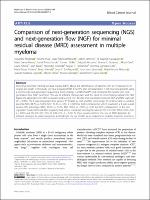| dc.contributor | Vall d'Hebron Barcelona Hospital Campus |
| dc.contributor.author | Medina, Alejandro |
| dc.contributor.author | Puig, Noemi |
| dc.contributor.author | Flores-Montero, Juan |
| dc.contributor.author | Jimenez, Cristina |
| dc.contributor.author | Sarasquete, Maria Eugenia |
| dc.contributor.author | Garcia-Alvarez, María |
| dc.contributor.author | Gironella Mesa, Mercedes |
| dc.date.accessioned | 2021-09-09T05:52:38Z |
| dc.date.available | 2021-09-09T05:52:38Z |
| dc.date.issued | 2020-10-30 |
| dc.identifier.citation | Medina A, Puig N, Flores-Montero J, Jimenez C, Sarasquete ME, Garcia-Alvarez M, et al. Comparison of next-generation sequencing (NGS) and next-generation flow (NGF) for minimal residual disease (MRD) assessment in multiple myeloma. Blood Cancer J. 2020 Oct 30;10:108. |
| dc.identifier.issn | 2044-5385 |
| dc.identifier.uri | https://hdl.handle.net/11351/6281 |
| dc.description | Mieloma; Factores de riesgo |
| dc.language.iso | eng |
| dc.publisher | Springer Nature |
| dc.relation.ispartofseries | Blood Cancer Journal;10 |
| dc.rights | Attribution 4.0 International |
| dc.rights.uri | http://creativecommons.org/licenses/by/4.0/ |
| dc.source | Scientia |
| dc.subject | Mieloma múltiple |
| dc.subject | Nucleòtids - Anàlisi |
| dc.subject.mesh | Multiple Myeloma |
| dc.subject.mesh | Sequence Analysis |
| dc.title | Comparison of next-generation sequencing (NGS) and next-generation flow (NGF) for minimal residual disease (MRD) assessment in multiple myeloma |
| dc.type | info:eu-repo/semantics/article |
| dc.identifier.doi | 10.1038/s41408-020-00377-0 |
| dc.subject.decs | mieloma múltiple |
| dc.subject.decs | análisis de secuencias |
| dc.relation.publishversion | https://doi.org/10.1038/s41408-020-00377-0 |
| dc.type.version | info:eu-repo/semantics/publishedVersion |
| dc.audience | Professionals |
| dc.contributor.organismes | Institut Català de la Salut |
| dc.contributor.authoraffiliation | [Medina A, Puig N, Jimenez C, Sarasquete ME, Garcia-Alvarez M] Departamento de Hematología, Hospital Universitario de Salamanca (HUSA/ IBSAL), CIBERONC, CIC-IBMCC (USAL-CSIC), Salamanca, Spain. [Flores-Montero J] Centro de Investigación del Cáncer-IBMCC (USAL-CSIC), CIBERONC, Salamanca, Spain. [Gironella M] Vall d’Hebron Hospital Universitari, Barcelona, Spain |
| dc.identifier.pmid | 33127891 |
| dc.identifier.wos | 000588057900002 |
| dc.rights.accessrights | info:eu-repo/semantics/openAccess |

 Área privada
Área privada Contacto
Contacto








